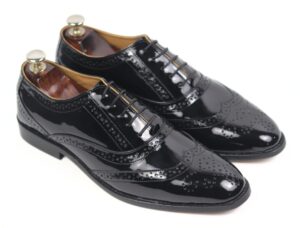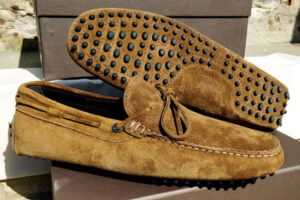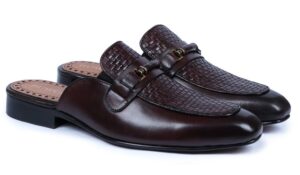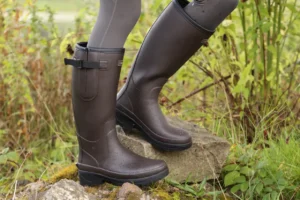Types of Shoes: 20 Different Types of Footwear
From running sneakers to patent leather pumps, many types of shoes protect your feet and make a fashion statement.

Definition of a Shoe:
A shoe is basically an outer covering intended to protect and comfort the human foot, typically having a thick or stiff sole with an attached heel and an upper part of lighter material (such as leather). The design of shoes has varied enormously through time and from culture to culture, with appearance originally being tied to function.
Different Types of Footwear:
Finding the right pair of shoes for an outfit or an event can be challenging. Below is a list of common types of shoes:
1. Athletic
Athletic shoes are shoes designed for sports, exercise, or recreational activities. They are made of flexible kinds of material featuring soles made from rubber and an upper part made with leather or canvas. There are different types of athletic shoes for various functions. Running shoes have additional sole support to protect the feet against ground impact, and tennis shoes are specifically designed to be flexible for tennis players. High-tops extend up to the ankles and provide stability to basketball players.
Athletic shoes, depending on the location and the actual type of footwear, can also go by the name trainers (British English), sandshoes (Australian English) running shoes or runners (Canadian English, Australian English, Hiberno-English), sneakers (American English, Australian English), sport shoes, gym shoes, tennis shoes, tennies, sneaks, kicks (American English), takkies (South African English).

2. Derby
A Derby shoe is defined by the way the lacing and eyelets close the shoe. These have an open lacing system meaning that quarters are stitched on top of the vamp (notice how there is no seam between the tongue and front of the shoe). Among all types of shoes, this shoe design offers a flexible fit and makes them easy to adjust for comfort with loosened or tightened laces.
Our rapidly progressing fashion footwear industry today prefers to think of the Derby as a crossover shoe that successfully straddles the fine line between Formal and Casual, blending traditional craftsmanship with modern style.

3. Oxford
An Oxford shoe is characterized by shoelace eyelets tabs that are attached under the vamp; a feature termed as closed lacing. Oxfords first appeared in Scotland and Ireland, it was here they first made their mark, initially recognized as Balmorals, a homage to the renowned Balmoral Castle.
As these types of shoes for men tiptoed into the spotlight, they quickly became the footwear of choice among the prestigious students of Oxford University in the vibrant 1800s. This newfound admiration gave birth to their iconic name – “Oxford”.
4. Brogue
Broguing is the term used to describe the pattern of holes that marks the outer leather of shoes. These decorative perforations were originally seen on Scottish and Irish boots that were used for outdoor or country footwear, though the wearing of a brogue has evolved over time to become appropriate in many instances.
Brogue shoes offer a blend of comfort and sophistication, ideal for pairing with anything from tailored suits to smart casual ensembles, ensuring a polished look for any occasion. A wingtip is a type of brogues that has a W-shaped, pointed toe cap with wings that run along the side of the shoe, ending before the ball of the foot. 
5. Monk Strap
Monk shoes are a distinguished style characterized by their distinctive buckle closure instead of traditional laces. With their sleek silhouette and sophisticated design, they offer a modern twist on classic elegance. Crafted from high-quality leather, monk shoes combine versatility and refinement, making them a stylish choice for both formal and smart-casual occasions.
The generally accepted knowledge within our industry suggests that the shoes date back to 15th century European monks whose days were spent labouring in fields. It is believed that these monks wore strapped sandals as their daily footwear.

6. Loafer
Loafers are slip-on shoes with a heel and rounded toe. When made out of leather, loafers can serve as a good pair of business shoes. Loafers made of fabric can be trendy casual wear shoes. Penny loafers are a version of loafers with a leather strap on top. Loafers are not only a versatile design but they are also a multi-functional shoe.
Slipping into a pair of loafers is an easy way to make an informal outfit look more refined. It almost goes without saying that loafers work perfectly with a pair of chinos.

7. Wholecut
Wholecut shoes are a type of dress shoe made from a single piece of leather, and are known for their sleek, minimalist look. Wholecut shoes are made from a single component of leather that covers the entire upper of the shoe. Thus, there are no joints, seams or stitching. The upper material can be plain and smooth or have some perforated decorations.
These shoes are usually expensive as cutting such a huge component from a leather side produces more leather wastage than usual.

8. Mocassin
Moccasins are a type of shoe without a heel and usually made from leather. Traditionally, they didn’t have any sole and instead were made from one single piece of material. It formed a wrap-like shape around the foot coming together with a seam at the top. Today, most moccasins do have a sole to make them more comfortable and practical, but they still feature bold seam lines in the design and don’t have a heel.
It’s common for moccasins to be decorated with tassels, beading or sometimes embroidery. Part of this is due to the history of the moccasin and the way they were worn in Native America. Moccasins protect the foot while allowing the wearer to feel the ground. The Plains Indians wore hard-sole moccasins, given that their territorial geography featured rock and cacti. The eastern Indian tribes wore soft-sole moccasins, for walking in leaf-covered forest ground.

9. Driving Shoe
A driving loafer is essentially a moccasin-construction slip-on with a snug but comfortable fit. The defining feature are the small rubber pebbles that cover the sole and extend to the back of the heel – they are very flexible and provide added grip on the pedals. Designed to afford the wearer greater control while behind the wheel and to prevent heel-wear to regular shoes, they were easy to change into before driving due to the lack of laces.

10. Boat Shoes
Boat shoes (also known as deck shoes or top-siders) are typically canvas or leather with non-marking rubber soles designed for use on a boat. A siping pattern is cut into the soles to provide grip on a wet deck; the leather construction, along with the application of oil, is designed to repel water; and the stitching is highly durable. Boat shoes are traditionally worn without socks.

11. Platform Shoes
Platform shoes are shoes, boots, or sandals with a thick sole, usually in the range of 5–10 cm (2–4 in). Platform shoes may also be high heels, in which case the heel is raised significantly higher than the ball of the foot. Extreme heights, of both the sole and heel, can be found in footwear such as ballet boots, where the sole may be up to 20 cm (8 in) high and the heels up to 40 cm (16 in) or more. The sole of a platform shoe can have a continuous uniform thickness, have a wedge, a separate block or a stiletto heel. Raising the ankle increases the risk of a sprained ankle.

12. Espadrilles
Espadrilles are a simple, stylish shoe that is nowadays made of jute fabric. Jute is a vegetable fiber from the Corchorus plant that grows in countries such as India and Bangladesh. It’s a versatile material used to make twine, sacks, curtains, and, of course, Espadrilles.
A Jute sole is the iconic feature of espadrilles. The style of jute on espadrilles ranges from a simple rope to an intricate design with braids. The jute can either be left in its natural tan state or bleached white. Most commonly, jute is attached to a rubber or rope sole using glue and stitches.

13. Mules
Mule is a style of shoe that has no back or constraint around the foot’s heel. Mules have a history going back to Ancient Rome but were not popularly worn until sixteenth-century Europe.

14. Flip-Flops
Flip-flops are a type of light sandal-like shoe, typically worn as a form of casual footwear. They consist of a flat sole held loosely on the foot by a Y-shaped strap known as a toe thong that passes between the first and second toes and around both sides of the foot. This style of footwear has been worn by people of many cultures throughout the world, originating as early as the ancient Egyptians in 1500 BC.
In the United States the modern flip-flop may have had its design taken from the traditional Japanese zōri after World War II, as soldiers brought them back from Japan. Flip-flops became a prominent unisex summer footwear starting in the 1960s.
15. Ankle Boot
Ankle boots are a type of short boot that covers the foot and ankle. They are available in a variety of styles, including low-heeled, calf-length, pull-on, and knee-length. Ankle boots can be worn for a variety of occasions, such as a summer alternative to sandals, with a cancan outfit, or with chains.

16. Chelsea Boot
Chelsea boots are close-fitting, ankle-high boots with elastic side panels. They often have a loop or tab of fabric on the back of the boot, enabling the boot to be pulled on. They are named after the Chelsea area of London. They are versatile and can be worn with a variety of outfits, including jeans, suits, and blazers.
Chelsea boots originated in Victorian England as a practical alternative to button-boots. Queen Victoria favored them for riding because they were easy to put on and take off. Chelsea boots are usually made from leather or suede and come in a variety of colors, but black, brown, and tan are the most popular.

17. Cowboy Boot

18. Hiking Boot
Hiking boots are designed to be comfortable and provide ankle support while walking long distances on rough terrain. They’re usually stiff and protect the hiker’s feet and heels. Good hiking boots need to offer a balance between light weight, support, and stability; cushioning and functionality; stiffness and breathability.

19. Knee High Boot
Knee-high boots are tall boots that reach around or just below the knee. They’re known for their slimming and flattering effect, as they visually lengthen the legs. Knee-high boots can be worn for formal occasions, and Wellington boots are a famous example of this type of boot.

20. Wellington Boot
A Wellington boot, often shortened to welly, and also known as a gumboot, rubber boot, or rain boot, is a type of waterproof boot made of rubber. Originally a type of leather boot adapted from Hessian boots, a style of military riding boot, Wellington boots were worn and popularised by Arthur Wellesley, 1st Duke of Wellington. They became a staple of practical foot wear for the British aristocracy and middle class in the early 19th century.



